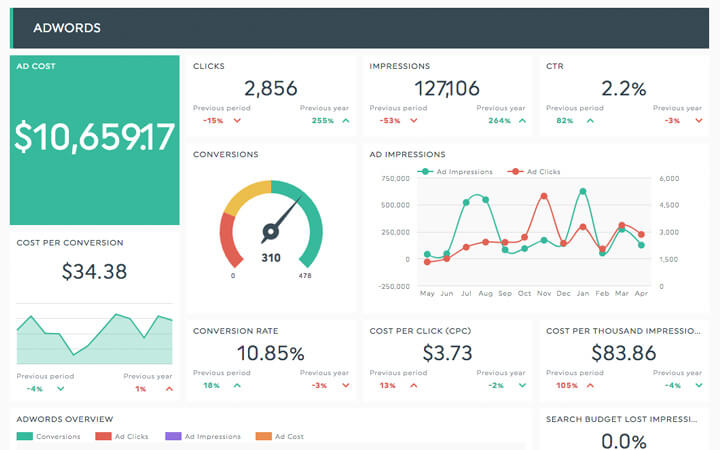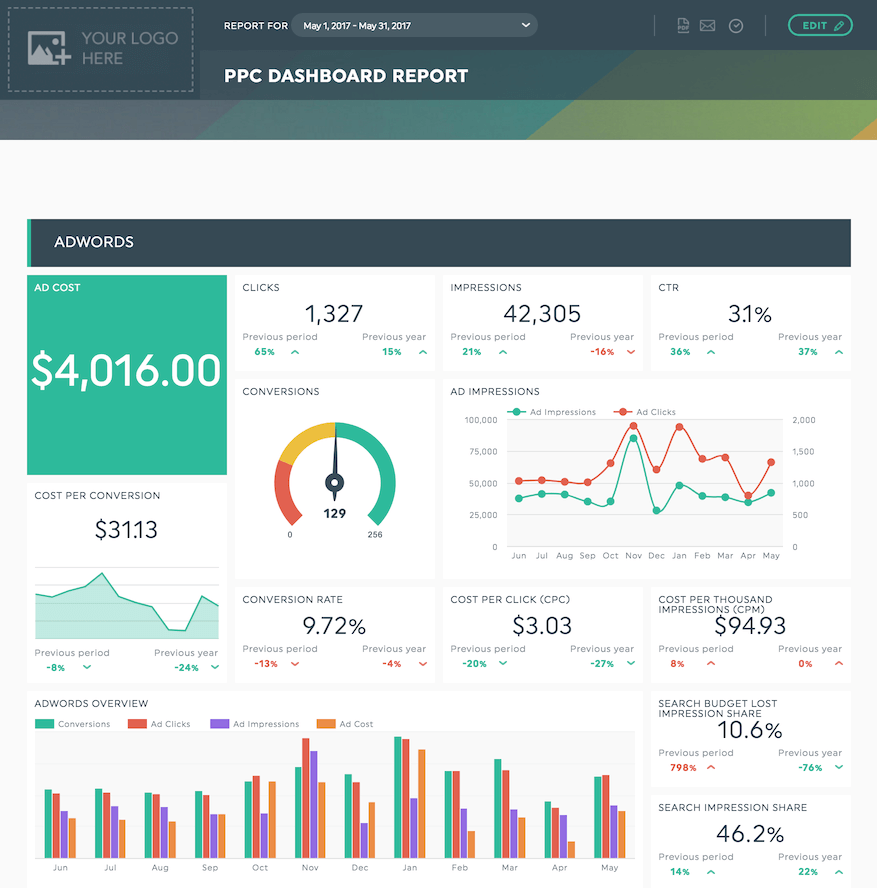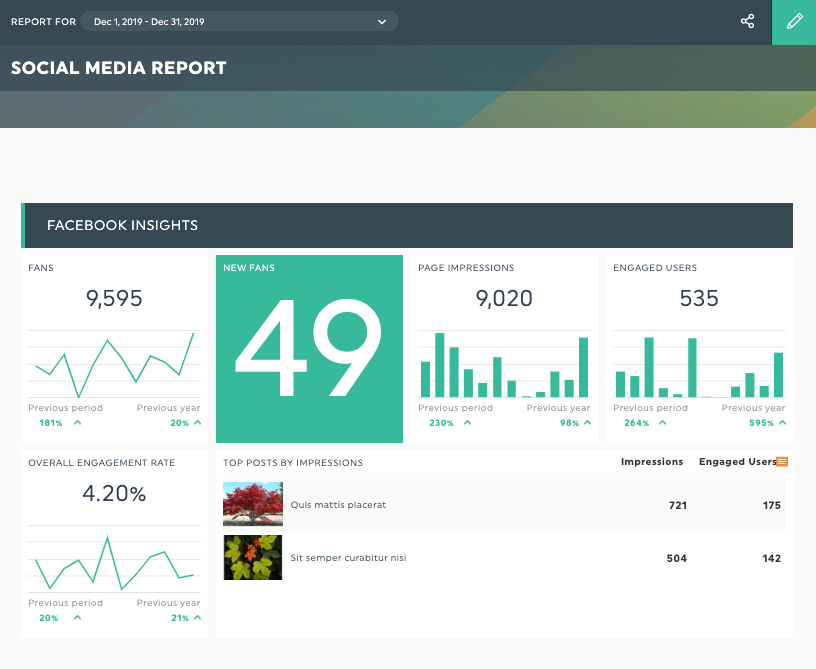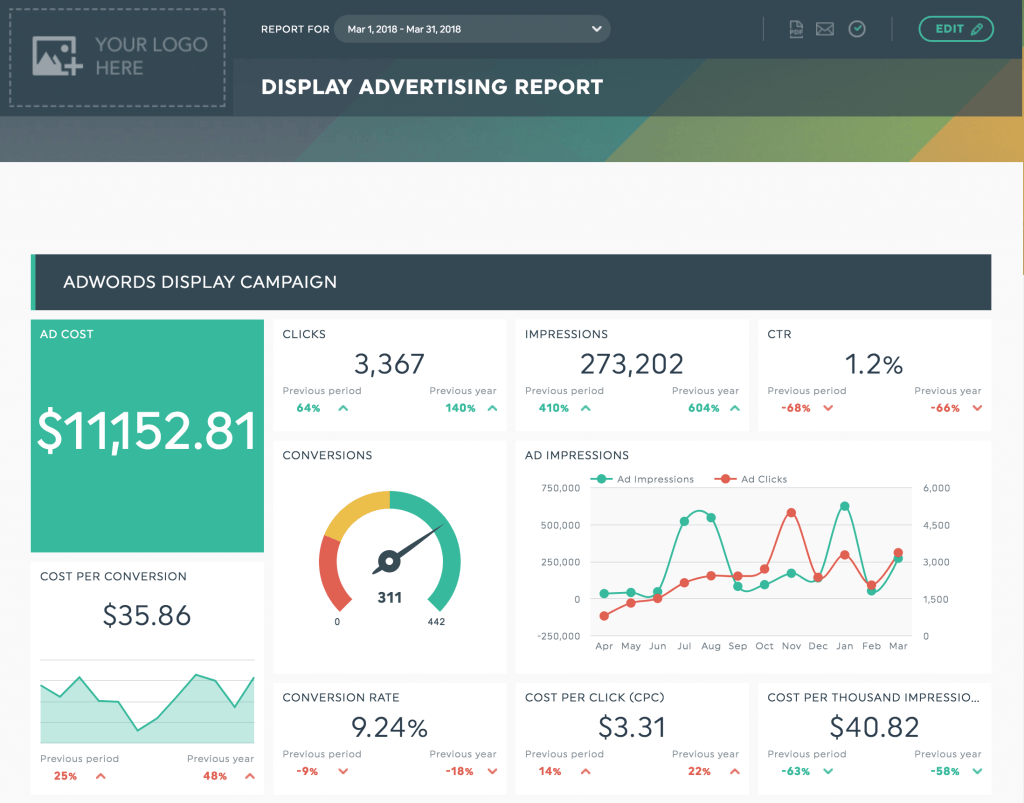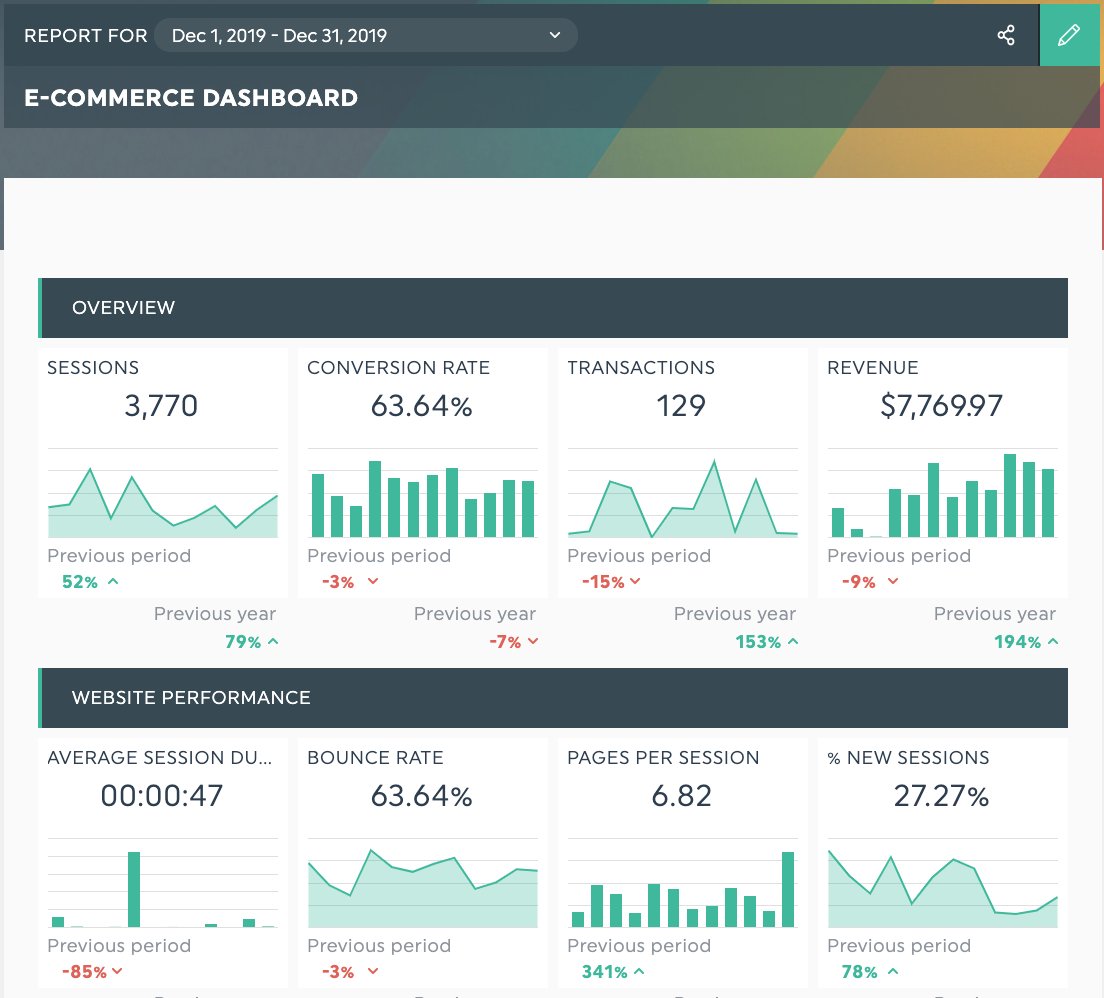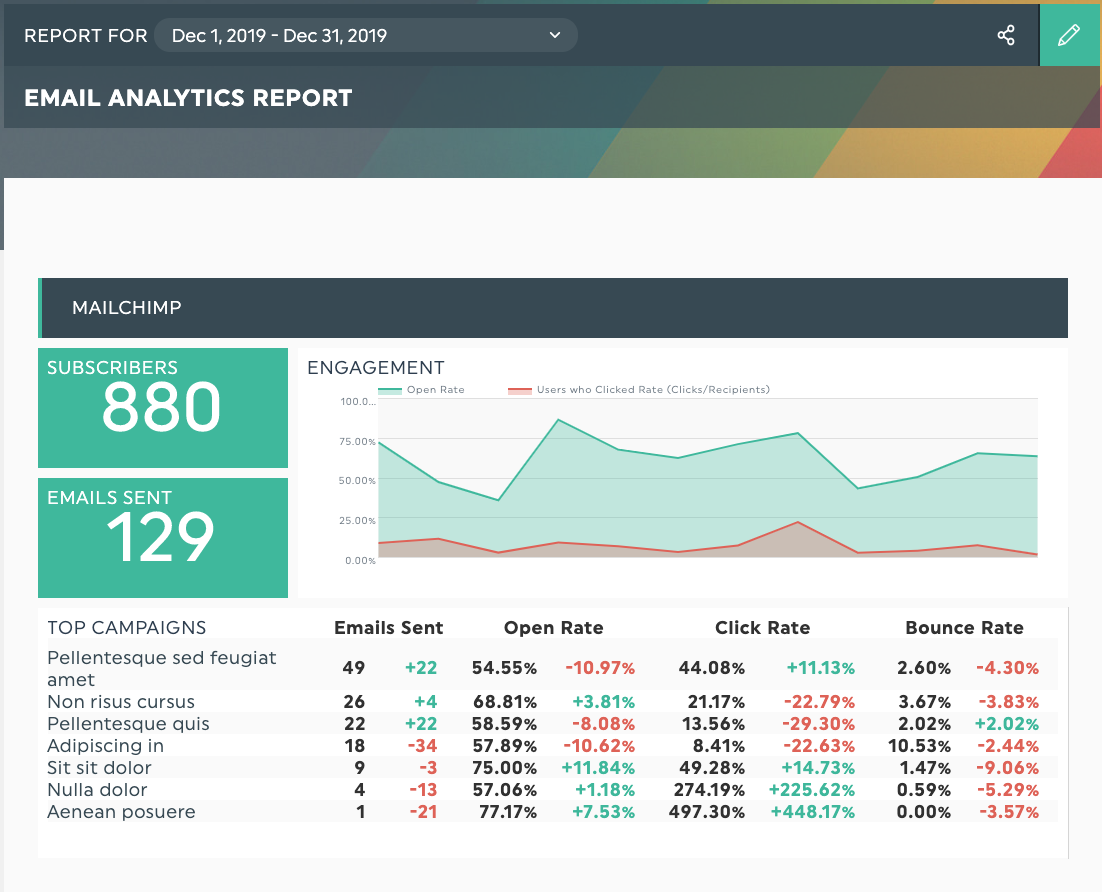7 Marketing Report Examples & Templates

You know that marketing reporting is essential to your marketing efforts: it tells you whether your marketing campaigns are performing well or your marketing strategy needs refinement. But you also don't want to spend all your time analyzing your marketing channels' performance.
That's where a good reporting tool with clear and automated marketing reports comes in.
See this report example with your own data
Here's everything you need to know about marketing reports, including how to create one and seven types of marketing report examples.
- What is a marketing report?
- Why do you need a marketing report?
- How often should you create a marketing report?
- How to present your clients' marketing data
- What marketing report templates should you use?
- 1. General marketing report example
- 2. SEO marketing report example
- 3. PPC marketing report example
- 4. Social media marketing report example
- 5. Display advertising campaign marketing report example
- 6. Ecommerce marketing report example
- 7. Email marketing report example
What is a marketing report?
A marketing report is a comprehensive analysis presented in real time through data visualization. It details the performance of various marketing channels to inform and help the marketing team, clients, and stakeholders make data-driven decisions.
Importantly, it lets you quickly and easily monitor your marketing performance across all your marketing channels and tells you where your digital marketing efforts are a success and where they might need to be optimized.
Why do you need a marketing report?
As a marketer, you want easy access to data on your key marketing metrics. A digital marketing report gives you all your marketing data, constantly tracked. You can use a Google Analytics report, a social media report, or all of these simultaneously.
You can include KPIs (key performance indicators) and data sets from all the top marketing channels, from Google Analytics to social media, email marketing to paid search, and more! There are many key metrics, and selecting the right ones can be tricky.
Luckily, automated marketing performance reports come with preset KPIs to get you started, and if you decide to track different metrics, you can do that: they're fully customizable.
How often should you create a marketing report?
We usually recommend creating reports on a monthly basis. While creating daily or weekly marketing reports can be helpful for you, the marketer and your clients may get overwhelmed by the sheer number of reports and start ignoring them—not what you want.
Monthly marketing reports allow you to gather enough data to see how changes have affected marketing results while ensuring that underperforming campaigns don't run too long. The best part is that whether you create a daily, weekly, or monthly report with a reporting tool such as Dashthis, you only have to create your report once, and your data will automatically be updated daily.
How to present your clients' marketing data
Giving your clients a clear and concise marketing dashboard is essential: it keeps them informed about the marketing efforts undertaken and, importantly, tells them whether they're getting a good return on investment on their marketing budget.
Here are some tips for creating a good marketing report:
- Use visuals - charts and graphs are much better than a written paragraph of statistics.
- Include results upfront - this is ultimately what clients are interested in and this should be page one of your report. Also include notes and explanations for why things happened the way they did so that your clients have a full understanding of the marketing campaigns' performance.
- Don't bury bad results - instead, include them upfront, explain what happened and what you're going to do about it. Clients will appreciate the honesty.
- Keep it concise - if you have a lot of material to cover that's fine but try to keep it short and snappy
- Use section headers - this makes it clear what you're talking about and makes your report easier to follow
- Incorporating multiple data sources helps you understand what's working and what's not. This allows you to make better, more informed decisions that match your business goals.
If you want to save even more time when preparing client explanations, AI Insights can analyze the dashboard for you and instantly provide clear takeaways you can share with clients, from wins to issues to opportunities. It’s a simple way to help clients understand the data without the long analysis process.
What marketing report templates should you use?
Our monthly marketing report templates are designed to save you time regarding marketing reporting. They're preloaded with the most relevant KPIs and fully customizable so you can change them according to your or your client's requirements.
Here are 7 of our most popular marketing report templates:
1. General marketing report example
This tremendous template will give you an overview of all your marketing activities. From content marketing to e-commerce analytics to search engine optimization, your marketing or sales team will have the critical data at their fingertips.
Remember that this report is an overview; if you want to examine the stats, check out the other templates below.
Some KPIs we recommend including are:
- Bounce rate
- Campaign performance
- Channel performance by traffic source (website traffic, organic traffic, paid traffic, referral traffic)
- Conversion rate
- Goal completions
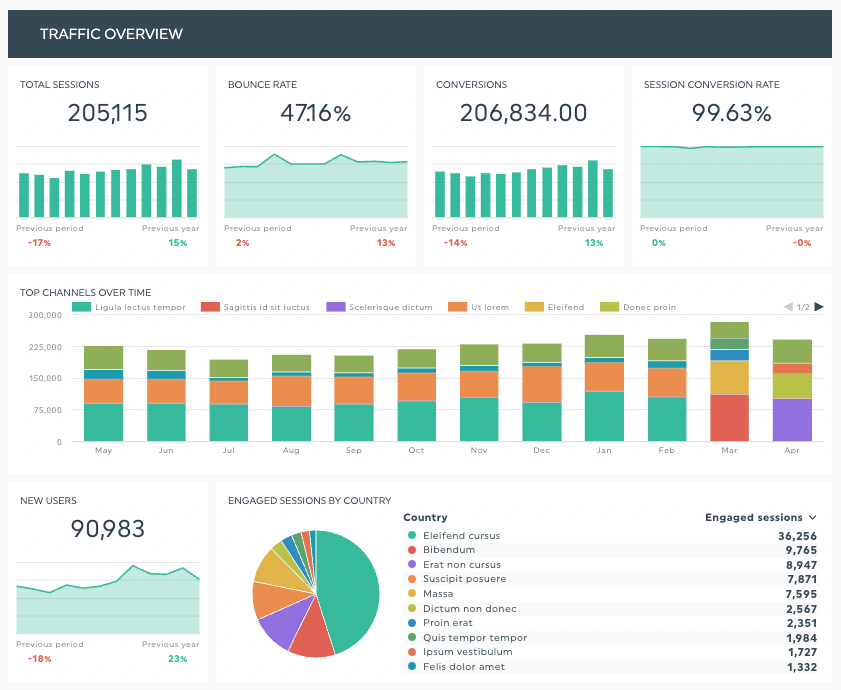
Use this report with your own data!
2. SEO marketing report example
SEO is a key part of any long-term digital marketing strategy. You probably already use Google Analytics dashboards, but this report will help keep you and your clients informed about how your SEO efforts are performing.
Key KPIs you should think about including in your SEO report include:
- Organic sessions
- Organic conversions
- Organic landing pages
- Keyword rankings
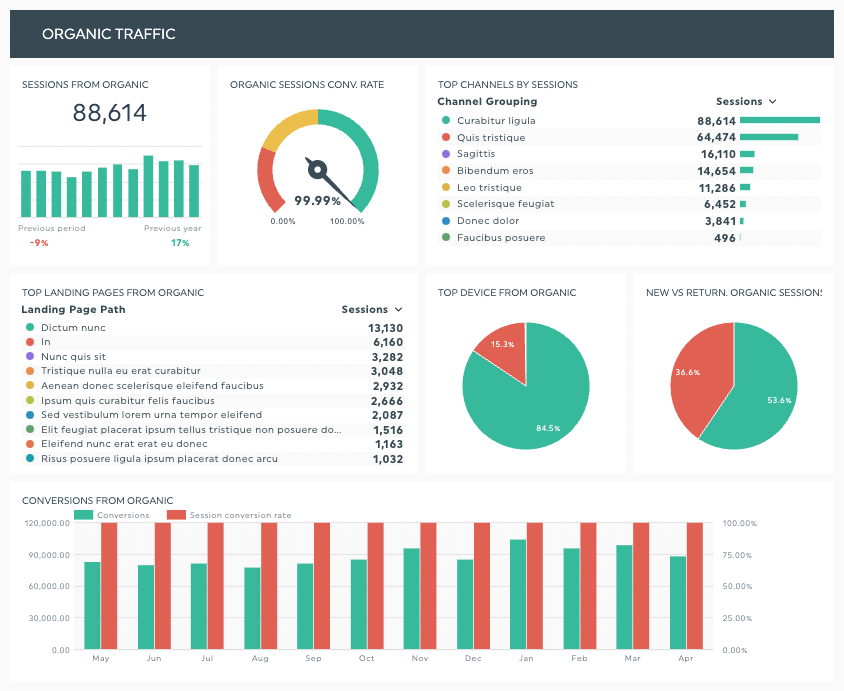
Use this report with your own data!
3. PPC marketing report example
The good thing about PPC is that the return on investment is easy to track. It's also a good strategy for driving conversions - but only if results are monitored and optimized.
Our PPC report supports Google Ads, Facebook Ads, Bing Ads, SEMRush, and more!
A good PPC marketing report will include stats on:
- Number of leads
- Revenues
- Clicks and costs
- Conversions
- Ad performance
We also recommend organizing your data by channel to get a breakdown of how each one is performing.
Use this report with your own data!
4. Social media marketing report example
There are two aspects to social media marketing: paid (like Facebook Ads) and organic (content marketing, for example). The most popular social media channels you're probably using for campaigns are Facebook, TikTok, Twitter, Instagram, YouTube, and LinkedIn, and you'll want to include all the ones you're currently using in your report.
Key KPIs that should be in your report are:
- Demographics of the target audience
- Likes and followers
- Impressions and reach
- Engagement rate
- Top performing posts
As with PPC marketing, the data in the report should be organized by social media platform for a clearer overview.
Use this report with your own data!
5. Display advertising campaign marketing report example
Bring all your advertising campaigns into one marketing report for a complete view of their performance with our display advertising campaign marketing report.
Whether using Facebook Ads or Google AdWords, this report should include all your display ad channels.
Your data should be organized by campaign and you should track the following KPIs for each campaign:
- Clicks
- Cost and cost per click
- Click-through rate (CTR)
- Impressions
- Conversions
Use this report with your own data!
6. Ecommerce marketing report example
As your products and services evolve and change, so should your e-commerce marketing strategy. Our e-commerce marketing report includes all the main KPIs you'll want to track to ensure you get the best possible results from your e-commerce marketing efforts.
Ecommerce marketing involves several marketing channels, from Google Analytics to social media, so there's no shortage of important metrics to track.
- Revenue
- Conversion rate
- Transactions
- Bounce rate
- Pages per session
- Average order value
Use this report with your own data!
7. Email marketing report example
Email marketing is a great way to get your products and services in front of people—they go straight into their inboxes. But you can't just fire out emails and hope for the best.
You've got to track how the campaigns are performing and how changes in content ultimately affect your bottom line.
That's where our email marketing report comes in.
KPIs your report should include are:
- Number of emails sent
- Unique open rate
- Click rate
- Overall campaign performance
Fundamentally, you want to track how many people opened your email and converted.
Use this report with your own data
Marketing reports built for marketers
DashThis has a bunch of other report templates that cover pretty well every aspect of digital marketing. All of them make reporting on marketing campaigns quicker and easier: DashThis fetches the data automatically, so you don't have to manually enter data into Word or Excel to generate different types of reports for your clients.
It's also full of functionalities and intuitive; reports can be created by dragging and dropping the widgets you want to display. Once you're happy with the report, it can be automatically delivered to whoever needs to see it.
Marketing analytics made easy! How fun is that?
P.S. If you ever wish your reports “just explained themselves,” DashThis now offers built-in AI Insights that analyze your dashboard and highlight everything you need to know.
Ready to save some time? Try out DashThis free for 15 days.
Try our report templates with your own data today!
Read More
Don’t miss out!
Automate your reports!
Bring all your marketing data into one automated report.
Try dashthis for free